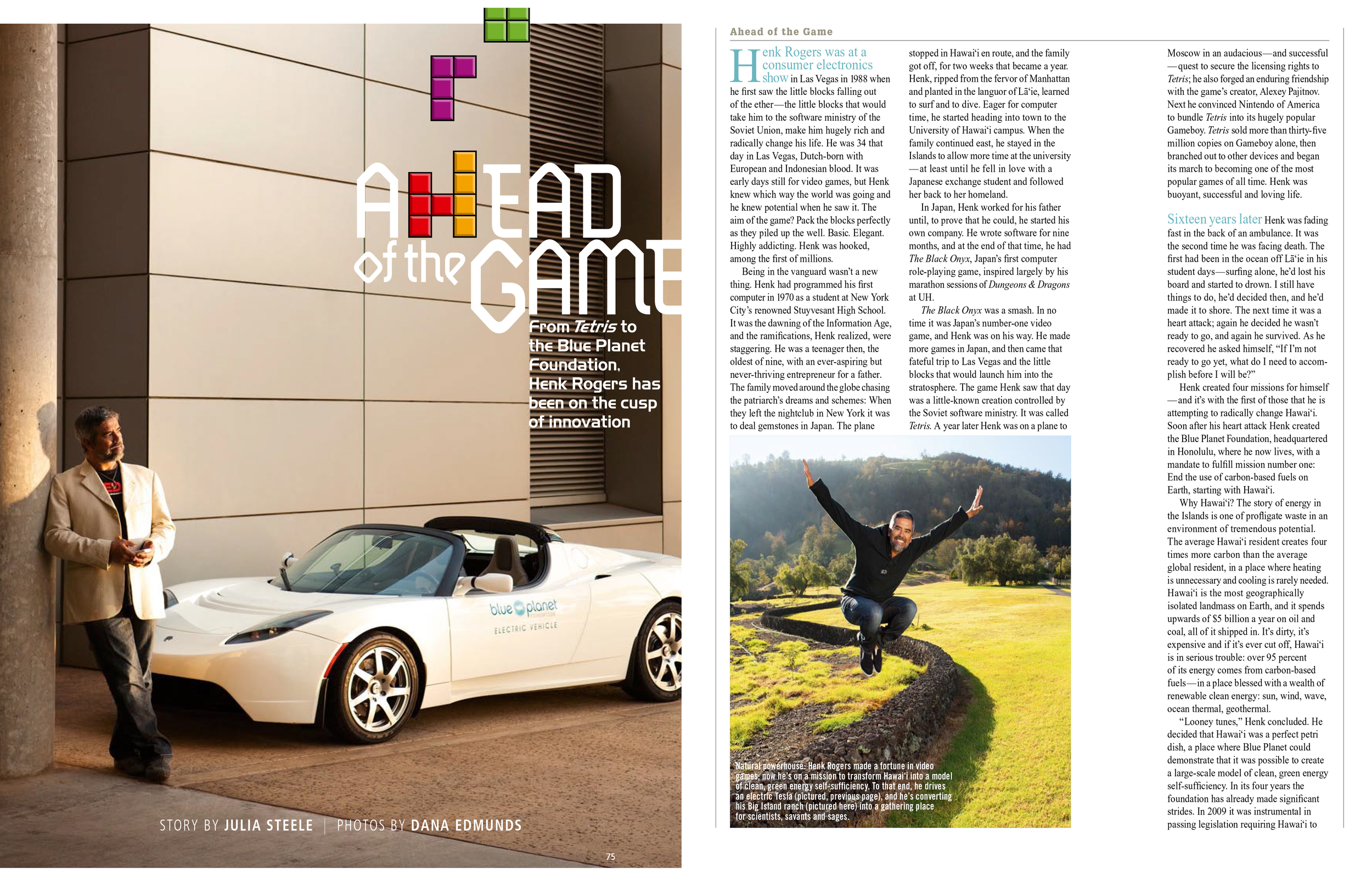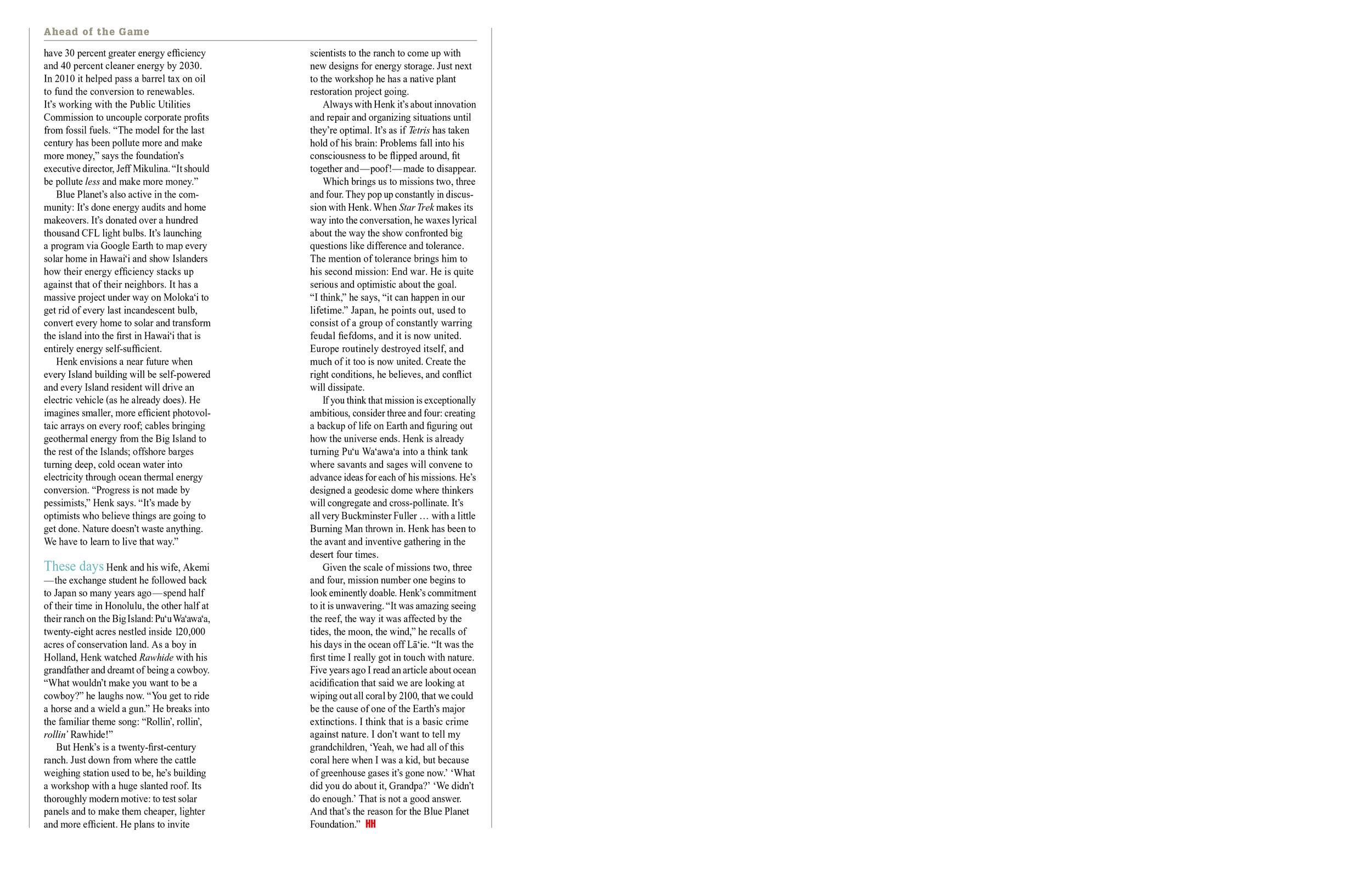Henk Rogers was at a consumer electronics show in Las Vegas in 1988 when he first saw the little blocks falling out of the ether—the little blocks that would take him to the software ministry of the Soviet Union, make him hugely rich and radically change his life. He was 34 that day in Las Vegas, Dutch-born with European and Indonesian blood. It was early days still for video games, but Henk knew which way the world was going and he knew potential when he saw it. The aim of the game? Pack the blocks perfectly as they piled up the well. Basic. Elegant. Highly addicting. Henk was hooked, among the first of millions.
Being in the vanguard wasn’t a new thing. Henk had programmed his first computer in 1970 as a student at Stuyvesant High School in New York City. It was the dawning of the Computer Age, and the ramifications, Henk realized, were staggering. He was a teenager then, the oldest of nine, with an ever-aspiring but never-thriving entrepreneur for a father. The family moved around the globe chasing the patriarch’s dreams and schemes: When they left the nightclub in New York it was to deal gemstones in Japan. The plane stopped in Hawai‘i en route, and the family got off, for two weeks that became a year. Henk, ripped from the fervor of Manhattan and planted in the languor of Lä‘ie, learned to surf and to dive. Eager for computer time, he started heading into town to the University of Hawai‘i. When the family continued east, he stayed in the Islands to allow more time at the university—at least until he fell in love with a Japanese exchange student and followed her to her homeland.
In Japan, Henk worked for his father until, to prove that he could, he started his own company. He wrote software for nine months, and at the end of that time, he had The Black Onyx, Japan’s first computer role-playing game, inspired largely by his marathon sessions of Dungeons & Dragons at UH.
The Black Onyx was a smash. In no time it was Japan’s number-one video game, and Henk was on his way. He made games in Japan, and then came that fateful trip to Las Vegas and the little blocks that would launch him into the stratosphere. The game Henk saw that day was a little-known creation controlled by the Soviet software ministry. It was called Tetris. A year later Henk was on a plane to Moscow in an audacious—and successful—quest to secure the licensing rights; he also forged an enduring friendship with Tetris’ creator, Alexey Pajitnov. Next he convinced Nintendo of America to bundle Tetris into its hugely popular Gameboy. Tetris sold more than thirty-five million copies on Gameboy alone, then branched out to other devices and began its march to becoming one of the most popular games of all time. Henk was buoyant, successful and loving life.
Sixteen years later Henk was fading fast in the back of an ambulance. It was the second time he was facing death. The first had been in the ocean off Lä‘ie in his student days—surfing alone, he’d lost his board and started to drown. I still have things to do, he’d decided then, and he’d made it to shore. The next time it was a heart attack; again he decided he wasn’t ready to go, and again he survived. As he recovered he asked himself, “If I’m not ready to go yet, what do I need to accomplish before I will be?”
Henk created four missions for himself—and it’s with the first of those that he is attempting to radically change Hawai‘i. Soon after his heart attack Henk created the Blue Planet Foundation, headquartered in Honolulu, where he now lives, with a mandate to fulfill mission number one: End the use of carbon-based fuels on Earth, starting with Hawai‘i.
Why Hawai‘i? The story of energy in the Islands is one of profligate waste in an environment of tremendous potential. The average Hawai‘i resident creates four times more carbon than the average global resident, in a place where heating is unnecessary and cooling is rarely needed. Hawai‘i is the most geographically isolated landmass on Earth, and it spends upwards of $5 billion a year on oil and coal, all of it shipped in. It’s dirty, it’s expensive and if it’s ever cut off, Hawai‘i is in serious trouble: over 95 percent of its energy comes from carbon-based fuels—in a place blessed with a wealth of renewable clean energy: sun, wind, wave, ocean thermal, geothermal.
“Looney tunes,” Henk concluded. He decided that Hawai‘i was a perfect petri dish, a place where Blue Planet could demonstrate that it was possible to create a large-scale model of clean, green energy self-sufficiency. In its four years the foundation has already made significant strides. In 2009 it was instrumental in passing legislation requiring Hawai‘i to have 30 percent greater energy efficiency and 40 percent cleaner energy by 2030. In 2010 it helped pass a barrel tax on oil to fund the conversion to renewables. It’s working with the Public Utilities Commission to uncouple corporate profits from fossil fuels. “The model for the last century has been pollute more and make more money,” says the foundation’s executive director, Jeff Mikulina. “It should be pollute less and make more money.”
Blue Planet’s also active in the community: It’s done energy audits and home makeovers. It’s donated over a hundred thousand CFL light bulbs. It’s launching a program via Google Earth to map every solar home in Hawai‘i and show Islanders how their energy efficiency stacks up against that of their neighbors. It has a massive project under way on Moloka‘i to get rid of every last incandescent bulb, convert every home to solar and transform the island into the first in Hawai‘i that is entirely energy self-sufficient.
Henk envisions a near future when every Island building will be self-powered and every Island resident will drive an electric vehicle (as he already does). He imagines smaller, more efficient photovoltaic arrays on every roof; cables bringing geothermal energy from the Big Island to the rest of the Islands; offshore barges turning deep, cold ocean water into electricity through ocean thermal energy conversion. “Progress is not made by pessimists,” Henk says. “It’s made by optimists who believe things are going to get done. Nature doesn’t waste anything. We have to learn to live that way.”
These days Henk and his wife, Akemi—the exchange student he followed back to Japan so many years ago—spend half of their time in Honolulu, the other half at their ranch on the Big Island: Pu‘u Wa‘awa‘a, twenty-eight acres nestled inside 120,000 acres of conservation land. As a boy in Holland, Henk watched Rawhide with his grandfather and dreamt of being a cowboy. “What wouldn’t make you want to be a cowboy?” he laughs now. “You get to ride a horse and a wield a gun.” He breaks into the familiar theme song: “Rollin’, rollin’, rollin’ Rawhide!”
But Henk’s is a twenty-first-century ranch. Just down from where the cattle weighing station used to be, he’s building a workshop with a huge slanted ceiling. Its thoroughly modern motive: to test solar panels and to make them cheaper, lighter and more efficient. He plans to invite scientists to the ranch to come up with new designs for energy storage. Just next to the workshop he has a native plant restoration project going.
Always with Henk it’s about innovation and repair and organizing situations until they’re optimal. It’s as if Tetris has taken hold of his brain: Problems fall into his consciousness to be flipped around, fit together and—poof!—made to disappear.
Which brings us to missions two, three and four. They pop up constantly in discussion with Henk. When Star Trek makes its way into the conversation, he waxes lyrical about the way the show confronted big questions like difference and tolerance. The mention of tolerance brings him to his second mission: End war. He is quite serious and optimistic about the goal. “I think,” he says, “it can happen in our lifetime.” Japan, he points out, used to consist of a group of constantly warring feudal fiefdoms, and it is now united. Europe routinely destroyed itself, and much of it too is now united. Create the right conditions, he believes, and conflict will dissipate.
If you think that mission is exceptionally ambitious, consider three and four: creating a backup of life on Earth and figuring out how the universe ends. Henk is already turning Pu‘u Wa‘awa‘a into a think tank where savants and sages will convene to advance ideas for each of his missions. He’s designed a geodesic dome where thinkers will congregate and cross-pollinate. It’s all very Buckminster Fuller … with a little Burning Man thrown in. Henk has been to the avant and inventive gathering in the desert four times.
Given the scale of missions two, three and four, mission number one begins to look eminently doable. Henk’s commitment to it is unwavering. “It was amazing seeing the reef, the way it was affected by the tides, the moon, the wind,” he recalls of his days in the ocean off Lä‘ie. “It was the first time I really got in touch with nature. Five years ago I read an article about ocean acidification that said we are looking at wiping out all coral by 2100, that we could be the cause of one of the earth’s major extinctions. I think that is a basic crime against nature. I don’t want to tell my grandchildren, ‘Yeah, we had all of this coral here when I was a kid, but because of greenhouse gases it’s gone now.’ ‘What did you do about it, Grandpa?’ ‘We didn’t do enough.’ That is not a good answer. And that’s the reason for the Blue Planet Foundation.”

